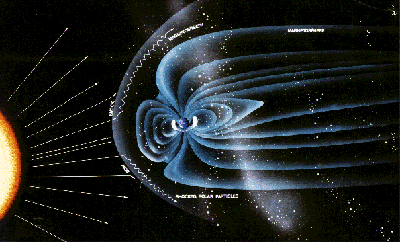
T H E S O L A R W I N D

Solar disturbances affect the Earth not only from changes in intensity of
radiation, but also through the solar wind - a gas of ionized, charged
particles streaming away from the sun at an average speed of 400 kilometers per
second. The solar wind is tenuous, containing only a few particles in a cubic
centimeter, mainly protons and electrons. This gas of charged particles -
called a plasma - can support electric currents. As a result, the Sun's
magnetic field is essentially "frozen in" to the moving plasma and is carried
out to the planets. The solar wind plasma flow impacts the Earth, where our own
geomagnetic field acts as a shield - forming the magnetopause and
magnetosphere, where most solar wind particles are unable to penetrate.
Despite this shielding effect, the Earth-magnetosphere system does react to
suddentstrong changes in the solar wind plasma and magnetic field. Sudden
changes in solar wind density may cause the magnetosphere to "balloon" out or
be compressed inwards, while magnetic fields in the solar wind and "reconnect"
with magnetic fields generated by the Earth and lead to an exchange of
particles and energy. Sudden changes in density or velocity may indicate we are
in a magnetic storm. If these increases are within days of a Halo CME, it is
likely that was the cause of the solar wind changes.
The ACE
spacecraft monitors the solar wind conditions "upstream" of the
Earth, before the flow arrives. A sudden change in the sign of Bz - the
z-component of the solar wind measured at ACE, essentially the north-south
direction of the magnetic field - can signal the beginning of a geomagnetic
substorm, in which energy begins to be transferred from the solar wind into the
Earth's near-space environment. Within hours this energy is released through
Aurora, when ionospheric currents become intensified and the Earth's magnetic
field rapidly reconfigures itself into an equilibrium.
CURRENT CONDITIONS
[CME]
[Solar Wind]
[Storms]
[Auroral Kp]
[Particles]
TUTORIALS
[Forecasting Space Weather]
[Aurora: Dawn of the North]